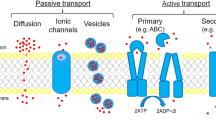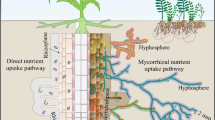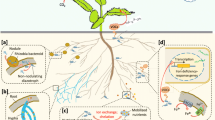Abstract
Phosphorus (P) is an essential nutrient with low bioavailability in soils for plant growth. The use of P solubilization fungi (PSF) has arisen as an eco-friendly strategy to increase this nutrient’s bioavailability. The effect of PSF inoculation and its combination with P-transporting organisms (arbuscular mycorrhizal fungi, AMF) on plant growth has been previously studied. However, these studies did not evaluate the combined effect of PSF and AMF inoculation on plant growth, symbiosis, and soil quality. Therefore, the aim of this study is to assess the impact of PSF on the AMF-wheat symbiosis establishment and efficiency, considering the effect on plant growth and soil quality. We performed a greenhouse experiment with wheat under different treatments (+/−AMF: Rhizophagus irregularis; +/−PSF strains: Talaromyces flavus, T. helicus L7B, T. helicus N24, and T. diversus) and measured plant growth, AMF root colonization, symbiotic efficiency, and soil quality indicators. No interaction between PSF and R. irregularis was found in wheat growth, showcasing that their combination is not better than single inoculation. T. helicus strains did not interfere with the AMF-wheat symbiosis establishment, while T. diversus and T. flavus decreased it. The symbiotic efficiency was increased by T. flavus and T. helicus N24, and unchanged with T. helicus L7B and T. diversus inoculation. The soil quality indicators were higher with microbial co-inoculation, particularly the alkaline phosphatases parameter, showing the beneficial role of fungi in soil. This work highlights the importance of microbial interactions in the rhizosphere for crop sustainability and soil quality improvement, assessing the effects of PSF on AMF-wheat symbiosis.




Similar content being viewed by others
References
Amberger A (2006) Characteristics of the tropics and subtropics. In: Amberger A (ed) Soil fertility and plant nutrition in the tropics and subtropics1st edn. International Fertilizer Industry Association, International Potash Institute, Paris, pp 2–30
Lewis Jr WM, Wurtsbaugh WA, Paerl HW (2011) Rationale for control of anthropogenic nitrogen and phosphorus to reduce eutrophication of inland waters. Environ Sci Technol 45:10300–10305. https://doi.org/10.1021/es202401p
Mulongoy K, Gianinazzi S, Roger PA, Dommergues Y (1992) Biofertilizers: agronomic and environmental impacts and economics. In: Da Silva EJ, Ratledge C, Sasson A (eds) Biotechnology: economic and social aspects. Cambridge University Press, New York, NY, pp 55–69
Della Mónica IF, Godoy MS, Godeas AM, Scervino JM (2018) Fungal extracellular phosphatases: their role in P cycling under different pH and P sources availability. J Appl Microbiol 124:155–165. https://doi.org/10.1111/jam.13620
Singh H, Reddy MS (2011) Effect of inoculation with phosphate solubilizing fungus on growth and nutrient uptake of wheat and maize plants fertilized with rock phosphate in alkaline soils. Eur J Soil Biol 47:30–34. https://doi.org/10.1016/J.EJSOBI.2010.10.005
Bhardwaj D, Ansari MW, Sahoo RK, Tuteja N (2014) Biofertilizers function as key player in sustainable agriculture by improving soil fertility, plant tolerance and crop productivity. Microb Cell Factories 13:66. https://doi.org/10.1186/1475-2859-13-66
Sharma SB, Sayyed RZ, Trivedi MH, Gobi TA (2013) Phosphate solubilizing microbes: sustainable approach for managing phosphorus deficiency in agricultural soils. Springerplus 2(587). https://doi.org/10.1186/2193-1801-2-587
Whitelaw MA (1999) Growth promotion of plants inoculated with phosphate-solubilizing fungi. In: Sparks DL (ed) Advances in agronomy. Academic Press, San Diego, California, USA, pp 99–151
Khan MS, Zaidi A, Ahemad M et al (2010) Plant growth promotion by phosphate solubilizing fungi – current perspective. Arch Agron Soil Sci 56:73–98. https://doi.org/10.1080/03650340902806469
Bolan NS (1991) A critical review on the role of mycorrhizal fungi in the uptake of phosphorus by plants. Plant Soil 134:189–207. https://doi.org/10.2307/42937062
Jangandi S, Negalur CB, Narayan M, Lakshman HC (2016) Synergistic effect between phosphate solubilizing bacteria and vesicular-arbuscular mycorrhizal fungi on growth and P uptake in Cajanus cajana L. (Pigeon pea). Int J Bioassays 6:5211–5213. https://doi.org/10.21746/ijbio.2017.01.005
Saxena J, Minaxi JA (2014) Impact of a phosphate solubilizing bacterium and an arbuscular mycorrhizal fungus (Glomus etunicatum) on growth, yield and P concentration in wheat plants. Clean - Soil, Air, Water 42:1248–1252. https://doi.org/10.1002/clen.201300492
Della Mónica IF, Stefanoni Rubio PJ, Cina RP et al (2014) Effects of the phosphate-solubilizing fungus Talaromyces flavus on the development and efficiency of the Gigaspora rosea-Triticum aestivum symbiosis. Symbiosis 64:25–32. https://doi.org/10.1007/s13199-014-0299-6
Wahid F, Sharif M, Steinkellner S et al (2016) Inoculation of arbuscular mycorrhizal fungi and phosphate solubilizing bacteria in the presence of rock phosphate improves phosphorus uptake and growth of maize. Pak J Bot 48:739–747
Della Mónica IF, Godeas AM, Scervino JM (2018) Microbial interactions: effect of biocontroller fungi and phosphorus solubilizers in the pre.symbiotic stages of arbuscular mycorrhizal fungi. Bol Soc Argent Bot 53:153. https://doi.org/10.31055/1851.2372.v53.n2.20500
Rodríguez MA (2004) Hongos del suelo antagonistas de Sclerotinia Sclerotiorum: Selección y estudio de potenciales agentes de biocontrol. Facultad de Ciencias Exactas y Naturales. Universidad de Buenos Aires
Scervino JM, Mesa MP, Della Mónica IF et al (2010) Soil fungal isolates produce different organic acid patterns involved in phosphate salts solubilization. Biol Fertil Soils 46:755–763. https://doi.org/10.1007/s00374-010-0482-8
Silvani VA, Fernández Bidondo L, Bompadre MJ et al (2014) Growth dynamics of geographically different arbuscular mycorrhizal fungal isolates belonging to the ‘Rhizophagus clade’ under monoxenic conditions. Mycologia 106:963–975. https://doi.org/10.3852/13-118
Murashige T, Skoog F (1962) A revised medium for rapid growth and bio assays with tobacco tissue cultures. Physiol Plant 15:473–497. https://doi.org/10.1111/j.1399-3054.1962.tb08052.x
Hewitt EJ (1966) Sand and water culture methods used in the study of plant nutrition, Technical. Commonwealth Agricultural Bureaux Horticulture and Plantation Crops, East Milling. Maidstone. Kent, England
Phillips JM, Hayman DS (1970) Improved procedures for clearing roots and staining parasitic and vesicular-arbuscular mycorrhizal fungi for rapid assessment of infection. Trans Br Mycol Soc 55:158–161. https://doi.org/10.1016/S0007-1536(70)80110-3
Tisserant B, Gianinazzi-Pearson V, Gianinazzi S, Gollotte A (1993) In planta histochemical staining of fungal alkaline phosphatase activity for analysis of efficient arbuscular mycorrhizal infections. Mycol Res 97:245–250. https://doi.org/10.1016/S0953-7562(09)80248-7
Kovar JL, Pierzynski GM (2009) Methods of phosphorus analysis for soils, sediments, residuals, and waters2nd edn. Virginia Tech University
Della Mónica IF, Saparrat MCN, Godeas AM, Scervino JM (2015) The co-existence between DSE and AMF symbionts affects plant P pools through P mineralization and solubilization processes. Fungal Ecol 17:10–17. https://doi.org/10.1016/j.funeco.2015.04.004
Battini F, Grønlund M, Agnolucci M et al (2017) Facilitation of phosphorus uptake in maize plants by mycorrhizosphere bacteria. Sci Rep 7(4686). https://doi.org/10.1038/s41598-017-04959-0
Minaxi SJ, Chandra S, Nain L (2013) Synergistic effect of phosphate solubilizing rhizobacteria and arbuscular mycorrhiza on growth and yield of wheat plants. J Soil Sci Plant Nutr 13:511–525. https://doi.org/10.4067/S0718-95162013005000040
Kaur G, Reddy MS (2017) Role of phosphate-solubilizing fungi in sustainable agriculture. In: Satyanarayana T, Deshmukh S, Johri B (eds) Developments in fungal biology and applied mycology. Springer Singapore, Singapore, pp 391–412
Yin Z, Fan B, Roberts DP et al (2017) Enhancement of maize growth and alteration of the rhizosphere microbial community by phosphate-solubilizing fungus Aspergillus aculeatus P93. J Agric Biotechnol 2:1–10. https://doi.org/10.20936/JAB/170201
Fernández Bidondo L, Bompadre J, Pergola M et al (2012) Differential interaction between two Glomus intraradices strains and a phosphate solubilizing bacterium in maize rhizosphere. Pedobiologia (Jena) 55:227–232. https://doi.org/10.1016/J.PEDOBI.2012.04.001
Vassilev N, Vassileva M, Nikolaeva I (2006) Simultaneous P-solubilizing and biocontrol activity of microorganisms: potentials and future trends. Appl Microbiol Biotechnol 71:137–144. https://doi.org/10.1007/s00253-006-0380-z
Stefanoni Rubio PJ, Godoy MS, Della Mónica IF et al (2016) Carbon and nitrogen sources influence tricalcium phosphate solubilization and extracellular phosphatase activity by Talaromyces flavus. Curr Microbiol 72:41–47. https://doi.org/10.1007/s00284-015-0914-7
Gianinazzi S, Gianinazzi-Pearson V, Dexheimer J (1979) Enzymatic studies on the metabolism of vesicular-arbuscular mycorrhiza. Ultrastructural localization of acid and alkaline phosphatase in onion roots infected by Glomus mosseae (Nicol. & Gerd.). New Phytol 82:127–132. https://doi.org/10.1111/j.1469-8137.1979.tb07566.x
Yun Y, Wang H, Man B et al (2016) The relationship between pH and bacterial communities in a single karst ecosystem and its implication for soil acidification. Front Microbiol 7(1955). https://doi.org/10.3389/fmicb.2016.01955
Illmer P, Schinner F (1992) Solubilization of inorganic phosphates by microorganisms isolated from forest soils. Soil Biol Biochem 24:389–395. https://doi.org/10.1016/0038-0717(92)90199-8
Illmer P, Schinner F (1995) Solubilization of inorganic calcium phosphates-solubilization mechanisms. Soil Biol Biochem 27:257–263. https://doi.org/10.1016/0038-0717(94)00190-C
Mosse B (1973) Plant growth responses to vesicular-arbuscular mycorrhiza. New Phytol 72:127–136. https://doi.org/10.2307/2430624
Abbott LK, Robson AD, Boer G (1984) The effect of phosphorus on the formation of hyphae in soil by the vesicular arbuscular mycorrhizal fungus, Glomus fasciculatum. New Phytol 97:437–446. https://doi.org/10.1111/j.1469-8137.1984.tb03609.x
Dick RP, Sandor JA, Eash NS (1994) Soil enzyme activities after 1500 years of terrace agriculture in the Colca Valley, Peru. Agric Ecosyst Environ 50:123–131. https://doi.org/10.1016/0167-8809(94)90131-7
Maseko ST, Dakora FD (2013) Rhizosphere acid and alkaline phosphatase activity as a marker of P nutrition in nodulated Cyclopia and Aspalathus species in the Cape Fynbos of South Africa. South African J Bot 89:289–295. https://doi.org/10.1016/J.SAJB.2013.06.023
Tarafdar JC, Claassen N (1988) Organic phosphorus compounds as a phosphorus source for higher plants through the activity of phosphatases produced by plant roots and microorganisms. Biol Fertil Soils 5:308–312. https://doi.org/10.1007/BF00262137
Acknowledgments
We highly appreciate the helpful comments by the editors and reviewers. We thank Dr. Vanesa Silvani and the In vitro Glomeromycota bank for the AMF strain provision. We thank Lic. M. Noel Salviolo for the English language revision.
Funding
This research was financially supported by the Consejo Nacional de Investigaciones Científicas y Técnicas (CONICET) and Agencia Nacional de Promoción Científica y Tecnológica (ANPCyT).
Author information
Authors and Affiliations
Corresponding author
Ethics declarations
Conflict of Interest
The authors declare that they have no conflict of interest.
Rights and permissions
About this article
Cite this article
Della Mónica, I.F., Godeas, A.M. & Scervino, J.M. In Vivo Modulation of Arbuscular Mycorrhizal Symbiosis and Soil Quality by Fungal P Solubilizers. Microb Ecol 79, 21–29 (2020). https://doi.org/10.1007/s00248-019-01396-6
Received:
Accepted:
Published:
Issue Date:
DOI: https://doi.org/10.1007/s00248-019-01396-6




